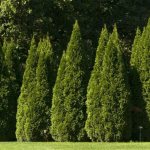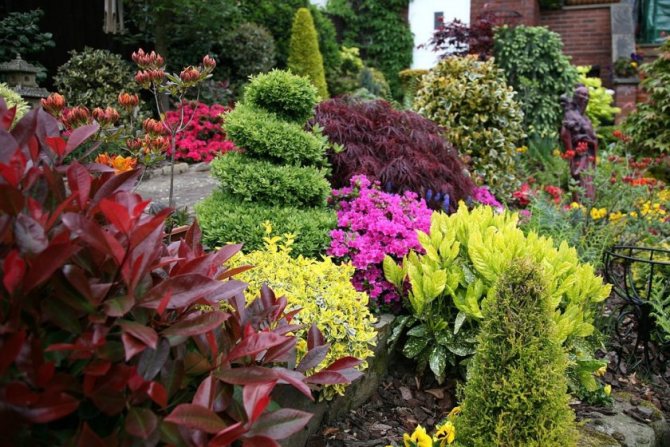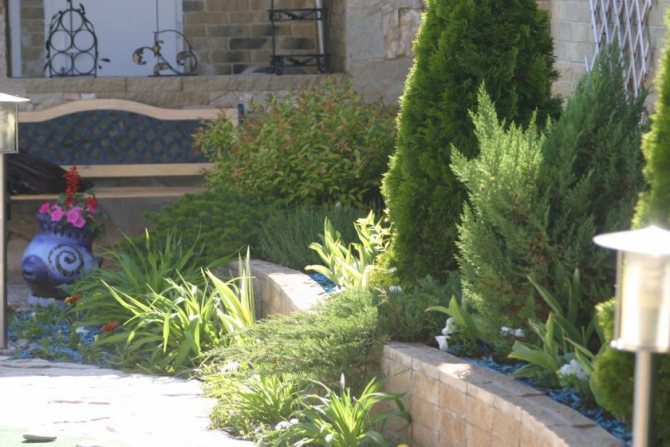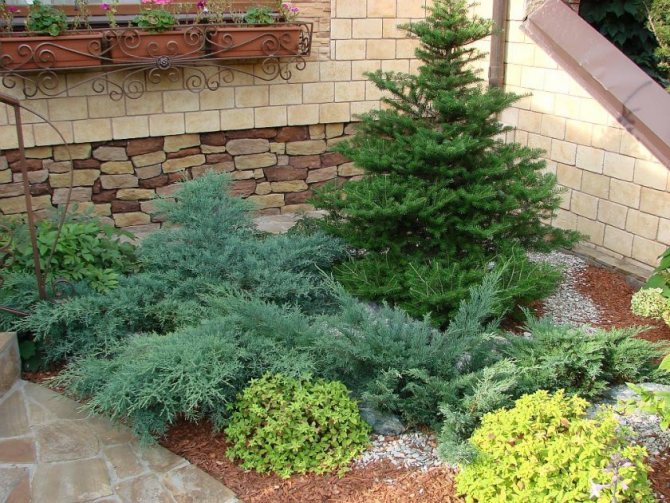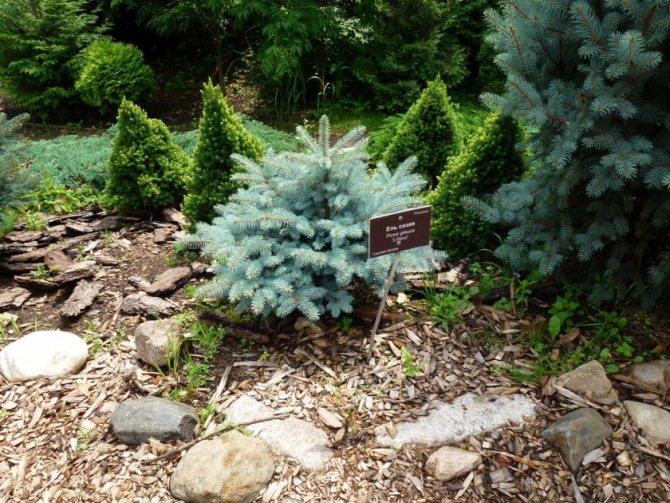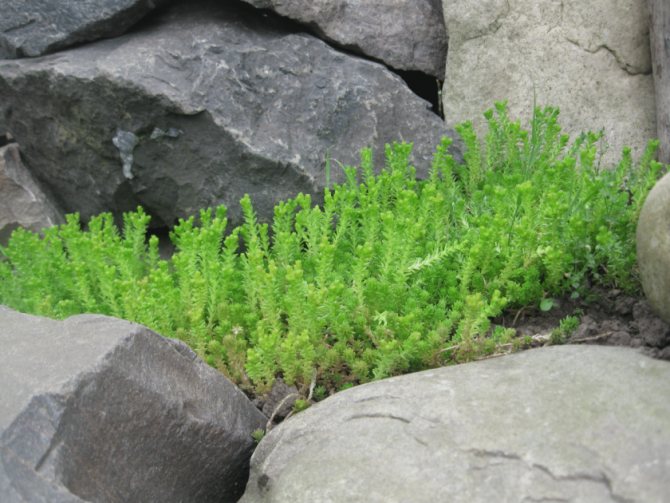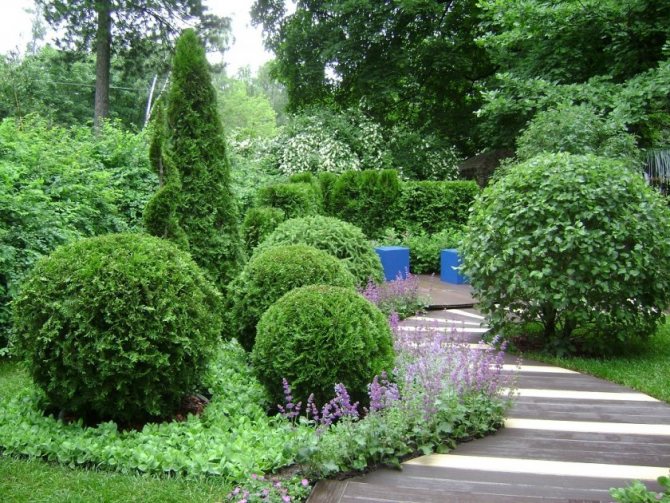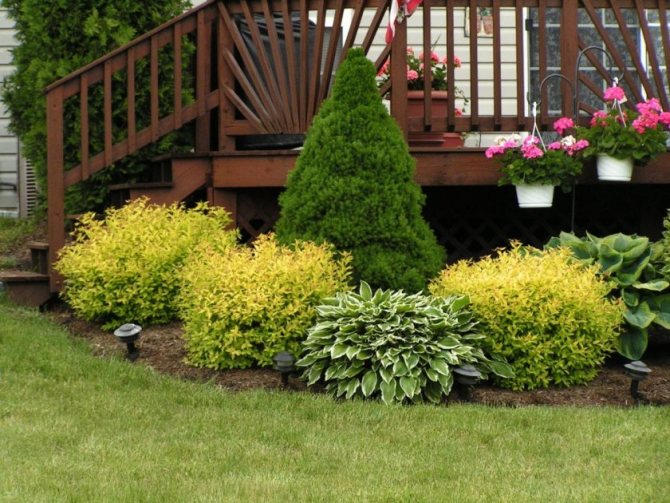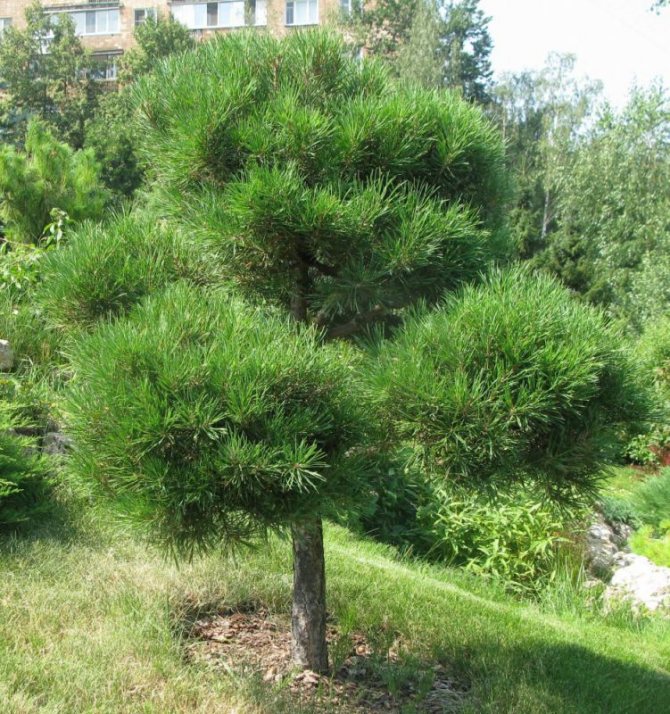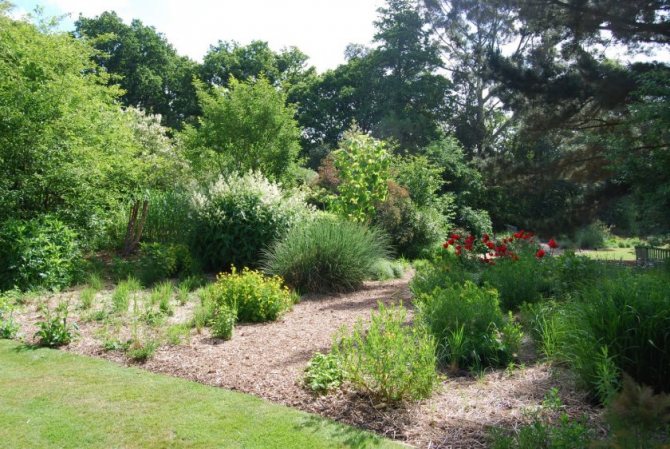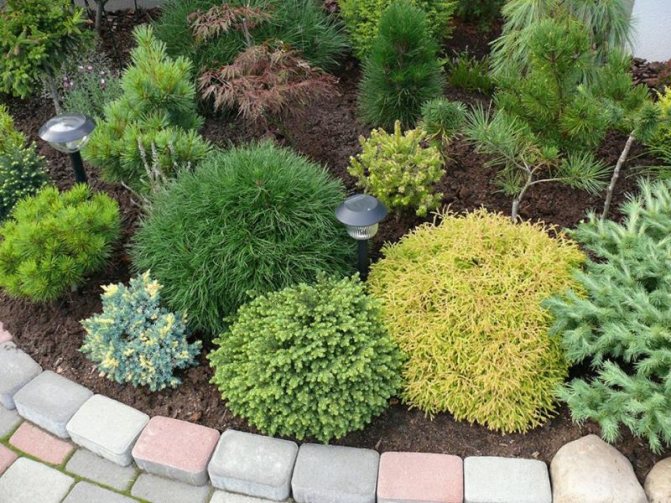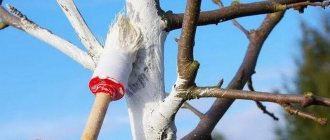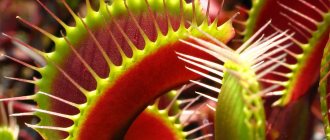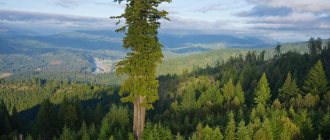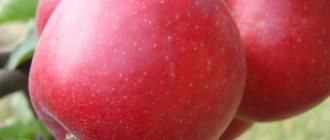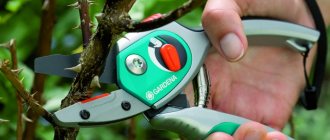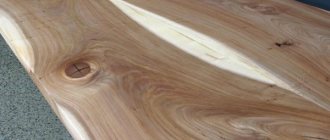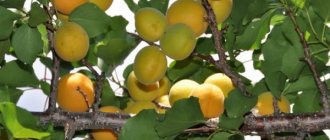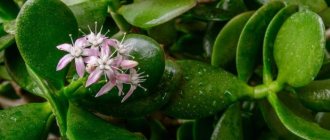Conifers for the garden: variety names and descriptions of species⬆
Not all types of conifers are suitable for decorating a site. Landscape designers have long identified specimens that not only take root well, but also create great combinations with other trees and shrubs. Each group has its own characteristics, advantages and disadvantages. It is worth noting that you can combine plants of different types.
Yew
The main representative of this species is yew. This is an evergreen plant can be as monoecious
,
and dioecious
... Leaflets in all representatives of the species are needle-like. They are arranged asymmetrically or in two rows.
All this family has about twenty representatives
... Since plants are demanding on air humidity and soil composition, they usually grow in the Northern Hemisphere. The large root system allows them to get the right amount of the necessary substances, and the drained soil gives them the opportunity for active growth.
Yew trees will not grow in wetlands or on land with high acidity levels. The best thing place them in the shaded area
where other plants will not be able to function normally due to lack of light. We recommend that you plant yew in places that are well protected from the wind. This arrangement will have a beneficial effect on the color of the plant.
Cypress
The difficulty of working with this group lies in the fact that all 12 types
require special treatment and conditions. Among the cypress
meet as heat-loving
,
and frost-resistant plants
... Most of the representatives of the family are trees, but there are also shrubs.
All evergreen cypress easily grown from seed
... They do not require additional care. The spectacular appearance of the trees has made them the favorites of landscape designers.
Planting plants with dark green needles is best in shaded areas where the sun will not burn out the crowns. But the yellow color signals a landing in a sunny area.
Pine
Plants of this family are common in Asia and Europe, they are very common in the wild, but not always suitable for garden decoration. The reason is that such trees usually reach a height of 50 meters
... Therefore, when choosing a plant, it is necessary to first clarify its estimated size. In a small area, pine in most cases will look ridiculous. Still, you can pick up a copy that fits well into the composition.
It is worth considering the fact that representatives of this family powerful root system
, which is actively growing. This means that a large space on the site must be allocated for it in advance, without forcing different plants to compete for access to vital resources.
The big plus of pine trees is that they are the same tolerate frost and heat well
, do not require special care and please you with their rich color of needles all year round.
Thuja
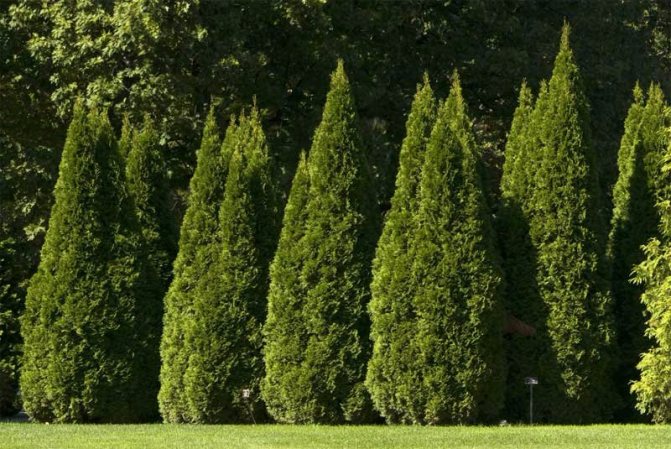
Compact columnar thuja of decorative varieties are found in almost every botanical garden and park. RAsthenia from the Cypress family is cultivated in Ukraine exclusively as an evergreen decoration. Gardeners in their reviews note the culture's resistance to decay, severe frosts and drought.
Thuja has a powerful superficial rhizome, branches growing upward, forming a column or pyramid shape, scaly dark leaves, small cones that ripen in the first year. Weeping, creeping and dwarf varieties have also been bred. Of these, the leading varieties of western thuja (occidentalis), which are distinguished by a fast-growing powerful trunk, reaching a height of 7 m, and branches up to 2 m in diameter. The needles of such a shrub are always green, regardless of the season. The ‘Sloth of Gold’ variety is distinguished by a rich orange tint of the needles; in winter, the branches acquire a copper tint. Such specimens are best cultivated in shady areas with neutral soil.
Did you know? Thuja spread to Europe thanks to King Francis of France, the first, who was an admirer of the unique cultures that appeared in his garden at Fontainebleau. He called the plant "the tree of life" and ordered it to plant significant areas around the palace. After 200 years, thuja was already cultivated in the east of Europe. At the same time, inexperienced gardeners were often disappointed, because they grew a miracle tree from seeds, and instead of the expected "Columna" they received a giant 30-meter monster with rare branches. It is such a thuja that grows in its natural environment.
A dense crown in the form of a narrow 7-meter column is created by branches of the medium-sized ‘Columna’ variety. It can be seen from afar by its dark green needles with a shiny tint, which does not change either in winter or in summer. Such a tree is frost-resistant, not demanding to care for. For small gardens, the compact 'Holmstrup' thuja varieties are suitable, which grow up to 3 meters in height and branch up to 1 m in volume, forming a lush conical shape of a rich green color.
The variety is characterized by increased frost resistance, tolerates pruning well, and is used mainly for creating hedges. Gardeners consider ‘Smaragd’ to be one of the best varieties of thuja with a conical crown. An adult tree reaches 4 m in height and 1.5 m in width. In young specimens, the branches form a narrow cone, and as it ages, it expands. The needles are juicy, green with a glossy sheen. Requires moist soil in care.
Tall conifers for the garden⬆
Such giants will look great on large areas, where you can appreciate their beauty without raising your head. Conifers are considered tall, the size of which exceeds 2 meters
... They can become both the central part of the composition and the background for other plants.
The following are in special demand:
- western thuja Brabant,
- one-color fir,
- European cedar pine,
- spruce prickly Hoopsii and others.
A small plot is not a reason to refuse a forest beauty. Thick needles at the bottom will form the basis of the composition. For example, the Watereri Scots pine, which reaches a height of 3 meters by the age of thirty, will look great in a small garden.
Brief description and classification
Conifers are a class of trees or shrubs belonging to the gymnosperm type, which includes about 600 species.
- These are mainly trees that reach the highest height in the world (mahogany grows up to 100 meters).
- The core of the coniferous wood is poorly formed, almost the entire mass of the trunk is formed from recycled wood.
- Leaves are small, needle-like, scaly, rarely fall off annually (larch). Very rarely, the leaves are large and flat. The sheet is represented by a needle.
- Flowers are collected in male and female cones. Male reproductive organs are in the form of scales, to which microsporangia are attached.
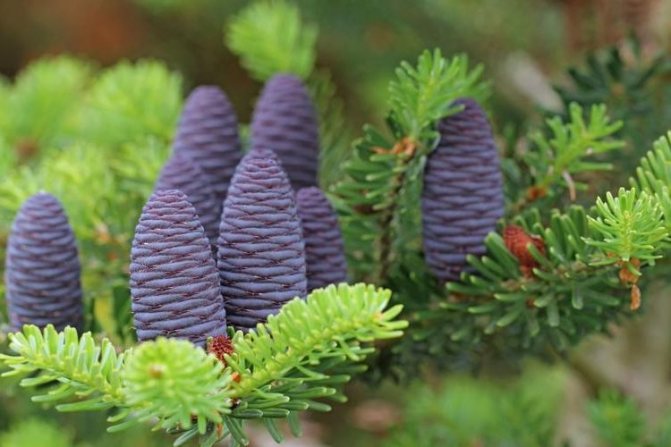

The taxonomy of conifers is constantly debated, so there are several options for classifying Pinopsida. One classification assumes the existence of the following types (clusters): Cycadophyta, Ginkgophyta, Gnetophyta, Magnoliophyta, Pinofyta.
In the past, the James Revel classification was used, which included 2 subclasses of Pinopsida:
- pines (Pinales);
- yew trees (Taxales) - contains only one family - yew.
An alternative division suggests having 3 subclasses:
- conifers (Pinaceae family);
- araucaria (Araucariaceae and Podocarpaceae);
- yew.
The pine subclass includes the following orders:


Dwarf conifers for the garden⬆
First of all, it is worth clarifying that dwarf conifers are far from being small in all cases. Everything in this world is relative, so a dwarf spruce can reach two meters in height. What are the wonders of selection? The original plant is over 50 meters in size.
But still, in most cases, dwarf plants do not move more than a meter from the ground. They look great in combination with stones and ornamental grasses.
Separately, it is worth highlighting:
- Spruce Lombers,
- mountain pine Hampi,
- Korean fir Piccolo.
Yew
Representatives of the species live mainly in the Northern Hemisphere. Like all conifers, they retain their modified green foliage all year round. Plants are interesting for their lifespan - over two thousand years and for their fruits - the only conifers that form not cones, but berries.
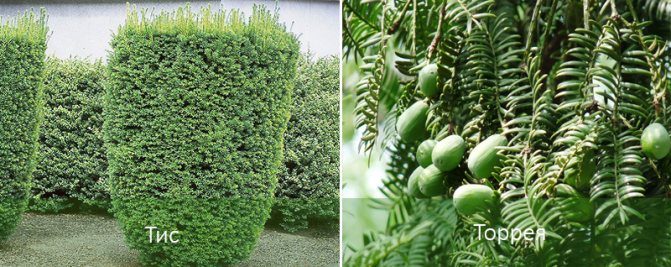

Yew is extremely poorly regenerated - seeds that have fallen from the mother tree almost never germinate. The reason is that coniferous litter, when decomposed, synthesizes substances that kill seedlings.
For decorative purposes, only a few species are grown: short-leaved, berry, pointed, Canadian. Although initially the height of yew trees exceeds the 10-meter mark, breeders have developed miniature varieties. Hybrids with a height of 30-100 cm are popular.
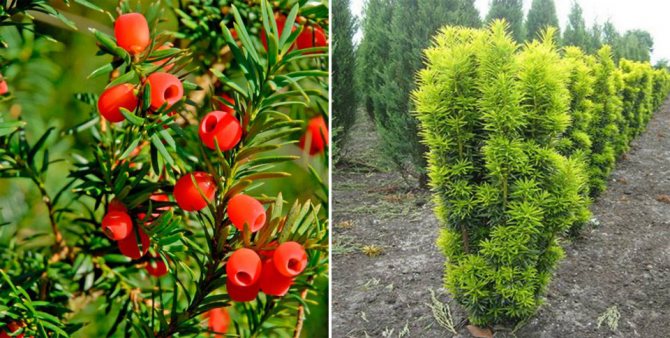

Yew tolerates frost well, is indifferent to lighting. Experienced gardeners plant it among other shrubs and stunted trees to reduce the risk of freezing. Yew does not like stagnant water, acidified soil, wind, drought, dusty, gassed air. Also, it does not emit essential oils characteristic of all conifers, and therefore has only decorative value. In most yews, all aerial parts and roots are poisonous!
Torrey
The plant is rarely grown on the territory of our country - it is thermophilic, the most suitable for it are the climatic conditions of the Black Sea coast of the Caucasus. The most common types are nutmeg and nutmeg torrei.
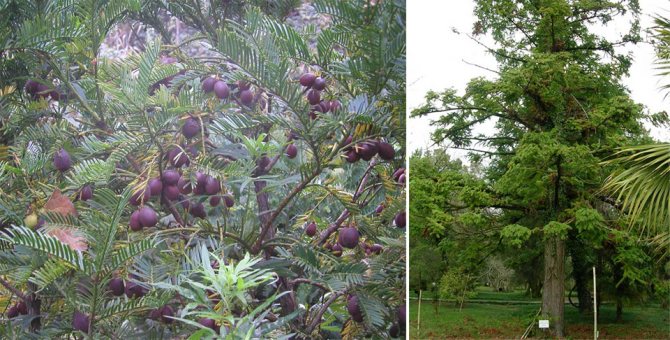

It is bred exclusively for practical purposes - nuts are edible, and are also used in the production of paints and varnishes.
Torreya is demanding in care, but new varieties with variegated needles are gradually winning the hearts of summer residents. It grows well on any soil, except for highly acidic ones. It does not make any demands on soil fertility. Loves good lighting, reliable wind protection. It tolerates moderate frosts well; only mulching of the trunk circle with a thick layer of organic matter is required.
Rules for the composition of conifers in the garden⬆
First of all, you need to remember that conifers can greatly increase in size. Growth takes a long time. But in order not to discover in 5-7 years that the composition has merged into a continuous canvas, you need to take into account the estimated size even before planting
.
You also need to understand which plants will grow strongly and which will remain small. Only in this case can an unpleasant situation be avoided when noticeably grown specimens cover the entire composition.
The ideal backdrop for conifers is a lawn.
... But it must be well-groomed. The combination of trees and shrubs will go well with the bright green of young grass.
Conifers can be freely formed into a single composition, including both dwarf trees and tall plants. They will not "merge" and will look spectacular due to the different sizes of needle-like leaves, as well as different shades of needles.
Mixborders
A complex composition that pleases the eye both in winter and in summer is a mixborder. Such a specific flower garden combines several types of plants at once
that bloom at different times. Conifers are included in the mixborder so that in winter it continues to attract attention and looks fresh and interesting. To create such a composition, designers recommend taking
several plants of different heights
... Conifers and tall shrubs are located at the very edge of the designated area, at the farthest from the point of view. After that, plants of medium growth are planted, and the last level is creeping shrubs and dwarf conifers.
Hedge
Another common way to distribute conifers on a site is disembarkation along paths or along the perimeter of the garden
... Moreover, such a fence can consist of several "layers". The trees are planted in a checkerboard pattern to leave room for a strong root system. But shrubs can form a solid line.
Wintering of conifers
Most outdoor conifers do not need shelter for the winter. It may be required only for miniature container crops that decorate terraces, balconies and summer cottages.


Container crops may not survive the winter
The root system is especially vulnerable. Therefore, such plants are transplanted into the ground for the winter with or without a container, and the soil around is mulched with a thick layer of peat, sawdust, compost or crushed bark.
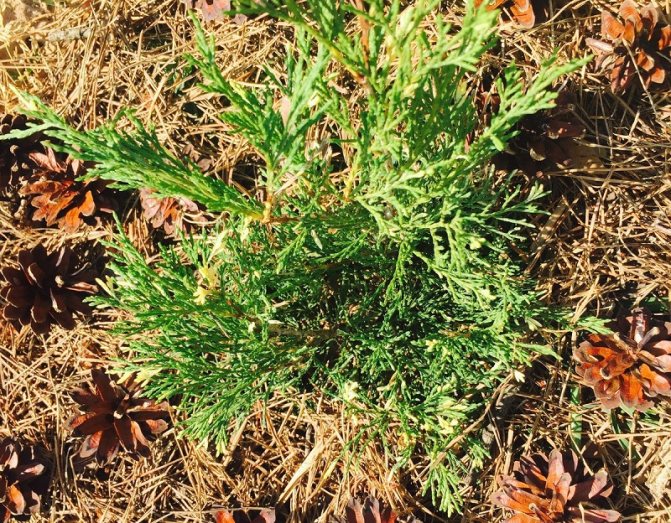

Ideal mulch - needles
Balcony plants, if they cannot be transplanted into the ground, are insulated differently: they place the pot in a large container and fill the space between the walls with crumpled paper, foam, peat or any other heat-retaining material. Then the container is placed on a piece of thick foam and the soil in the pot is mulched or covered with a layer of snow.
The needles of plants wintering in areas open to the sun must be protected from burns. They most often occur in late winter and early spring, when the frosts are still strong, but the sun is already shining brightly.
To do this, large plants are covered with non-woven material, and over small ones, you can build a hut from branches.
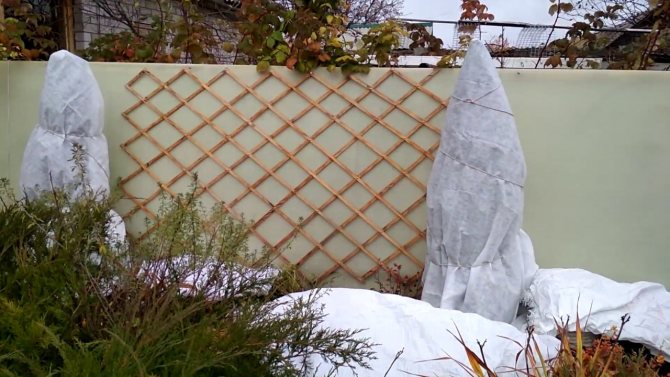

Such wrapping will also protect the branches from fractures under the weight of snow.
Features of caring for conifers for the garden⬆
The unpretentiousness of conifers is their indisputable advantage, but still, even they need care. It is especially important to keep an eye on young seedlings, their further fate depends on care in the first year of "life" on the site.
It is worth remembering that each plant has its own special needs. So, for example, some trees need watering once every two weeks, while others need watering once a month. Moreover, all seedlings must be watered at least once a week
... After they take root, you can switch to the standard mode for this type.
Additional feeding
desirable but not critical. Since conifers do not need to spend energy on the formation of foliage every year, nutrients are consumed more slowly. For feeding, it is best to use
complex mineral fertilizers
.
Not all conifers are frost-resistant, so some plants need to be covered for the winter. Also, in the heat, you should monitor the condition of the needles, you may need protection from sunlight.
Pruning branches regularly
, shaping and getting rid of weeds and diseased plants is the key to a beautiful and prosperous garden.
Will decorate your garden all year round. The leaves of these plants are modified, they look like green needles, which are called needles, and the plants, respectively, are conifers. Most conifers do not shed their leaves for the winter, so they remain green when all nature is dormant.
The lush crowns of coniferous trees, sprinkled with snow, look fabulous, and for the New Year holidays they can be decorated with toys and garlands. In summer, conifers and shrubs create a picturesque scene combined with other garden plants.
Conifers will always remain fashionable and in demand. Now the market offers a large assortment of coniferous seedlings of various varieties and species. Before choosing and buying a coniferous tree, study not only the external qualities of this plant - the future size of an adult plant, the shape of the crown, you also need to know the growth rate, frost-resistant and drought-resistant qualities, soil and light requirements. For decorative forms of conifers, the requirements for care and winter hardiness are usually the same as for the original species, therefore it is necessary to distinguish main types of conifers
.
If you buy seedlings of coniferous trees imported from countries with a mild climate, then most often you will fail, since conifers that are not adapted to frosty winters, dry air and bright spring sun usually die or get sick for a long time. Non-frost-resistant conifers include: araucaria (Araucaria), Japanese and Spanish fir (Abies fargesii, Abies pinsapo), calocedrus (Calocedrus), Himalayan cedar (Cedrus deodara), cypress (Pinio), pine Pinus leucodermis), Japanese pine (Pinus parviflora), berry yew, eastern thuja.
The following list of conifers is suitable for growing in the climatic conditions of central Russia:
The traditional conical shape of the tree is familiar to our eyes. Trees look good at the front entrance, along the main road, or in the background of flower beds and lawns. The Christmas tree is a symbol of the most awaited holiday of the New Year. Grows in our forests common spruce (Picea
abies)
and reaches a height of 20-25 meters. To decorate gardens, many compact varieties of fir trees with a dense crown of a regular conical shape have been created.
Colorado spruce (Picea
pungens)
differs in unpretentiousness, endurance and high decorative qualities. The homeland of this spruce is North America, where there are severe frosts in winter, and hot sun in summer, from which the tree protects the wax coating on the needles. A large number of varieties of blue spruce have been created on the basis of prickly spruce. It has a similar bright blue needles
spruce canadian or gray (Piceaglauca
), but it is less known in our country.
Fir
prized for the healing properties of the resin. Fir and spruce are very similar in appearance, these two types of conifers can be distinguished by several characteristics. In a Christmas tree, cones hang down from the branches, and in fir trees, cones sit vertically on the branches. The needles ate hard, sharp, tetrahedral. Fir needles are soft, flat. The needles of the fir tree are easily separated from the branches, and the needles of the spruce come off with a piece of bark.


You may ask, why distinguish between these two identical in appearance trees? The fact is that they have different requirements for growing conditions. Fir trees love fertile soil, do not tolerate near groundwater, as well as trampling and paving the surface of the earth. Fir-trees are moisture-loving; in dry summers they need to be watered regularly.
Fir trees prefer drained soil. Fir roots penetrate deeply into the soil, while the root system of fir trees is located at a depth of 50-70 cm and often strong winds knock over the trees, twisting their roots with a clod of earth. Firs do not like polluted air, they are shade-tolerant, but they grow better in a sunny place.
Narrow conical crowns Siberian fir (Ables
sibirica
) are compact, great for creating vertical lines in the garden. Fir needles can be bright green to light blue in color. Based
balsam fir (Ablesbalsamea)
decorative varieties in the form of thick flat pillows have been created. Varieties
Korean fir (Ableskoreana)
winter successfully in our climate.
White fir (Ablesconcolor
) stands out with long bluish needles.


Pine
a beautiful coniferous tree with long fluffy needles. In nature, pine trees reach a height of 20-25 meters, and the crown spreads up to 5 meters in diameter, so for small gardens it is necessary to choose compact and dwarf forms for planting.
Scots pine (Pinussilvestris
) has several varieties with a compact dense crown and beautiful bluish needles.
Mountain pine (Pinusmugho
) reaches a height of 4-5 meters. Imported from America
Weymouth pine (Pinusstrobus
) attracts attention with soft tender needles, which makes the crown of the tree very lush.
Pine yellow (Pinusponolerosa
) is rarely found in gardens, its main difference is long needles, up to 20 cm.
Siberian cedar pine (Pinussibirica)
better known as cedar. This is a winter-hardy, slow-growing species with bluish needles, but you should not buy cedar seedlings to get cones, since it begins to bear fruit at the age of 50. To plant pine trees, set aside an open, sunny place with well-drained, slightly alkaline soil.
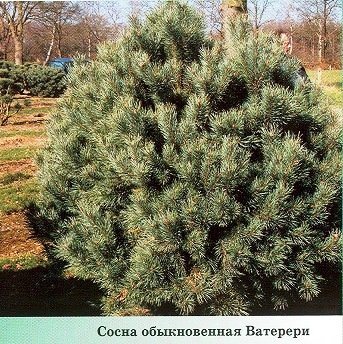

The only coniferous plant that sheds leaves for the winter - larch
... In spring, the larch is covered with new soft green needles, and before the needles appear, female and male flowers bloom. Larch grows rapidly and can reach a height of 20 meters. Larch is very unpretentious, frost-resistant, drought-resistant. The most widespread are
European larch (Larixdecidua
) and
Siberian larch (L.sibirica
). Japanese larch (L. leptolepis) has a beautiful weeping form.


Tuya (Thuja)
has unusual scaly needles. Flat openwork tree branches, like fans, look in different directions, creating a lush crown. Only western thuja (Thuja occidentalis) has the necessary winter-hardy qualities; from this species, many decorative varieties have been created for our gardens with different shapes of tree crowns and color of needles.
Yew (Taxus)
attracts attention with spectacular needles and a beautiful structural crown. The most popular berry yew (Taxus baccata), but this species hibernates only under cover. Suitable for growing in Russian gardens
pointed yew (Taxuscuspidata) and Canadian yew (Taxuscanadensis
). Yews prefer shady areas with fertile, moist soil.
Cypress (Chamaecyparis)
has a scaly needles similar to that of a thuja. Small thin twigs create a dense lush crown. Branches can be straight, spreading, drooping, respectively, creating a crown of a tree of a columnar, spreading or weeping shape. The most winter-hardy species -
pea cypress (Chamaecyparis pisifera)
.
The strict shapes of conifers will always be appropriate in almost any landscape design. In summer, conifers are ideally combined with a green lawn in the yard and other flowering plants, and in winter, conifers are able to save a summer cottage with their bright green color and branching from gray days and lifelessness. In addition, coniferous shrubs and trees can give clean air enriched with healing essential oils.
Modern gardeners can no longer imagine their garden without evergreen trees and shrubs. And there are plenty of conifers to choose from. Below you can find some conifers that will be an excellent garden decoration and fit perfectly into landscape design.
Landing features
While some types of conifers require special planting conditions, there are general rules for all of their species. In particular, the planting time is an important point, for conifers this is the end of April - beginning of May.
As mentioned above, the easiest way to grow crops is from seedlings. The only thing you need to pay attention to is their quality, which is indicated by the following points:
| Earthen lump | Must be whole and packed in burlap. The size of the lump should be one third of the length of the seedling. |
| Needle color | If the seedling is healthy, then the color of the needles is saturated, the needles are elastic. |
Brief instructions for planting needles are as follows:
- First of all, you need to dig a hole with a volume slightly larger than the earthen clod of the seedling.
- Then in the hole it is necessary to fill a mound 2/3 of its depth high.
- After that, a seedling should be placed on a mound and the roots should be carefully distributed around it.
- Next, the roots need to be buried. In this case, the seedling must be periodically shaken and slightly trampled on the ground.
- After planting, the plant must be watered.
- Then sprinkle dry soil around the seedling.
- At the end of the work, the soil should be mulched and sprinkled with peat around the plant.
These are, perhaps, all the main points of planting conifers.
Spruce: description with photo
Fir trees are tall, slender conifers that will look very effective both individually and in compositions. Professionals are able to build whole coniferous hedges
... Nowadays, spruce is not only a tall large crop for everyone, which has delighted us since childhood. In winter, a spruce planted in the yard
you can dress up with Christmas toys
... Such a living beauty will certainly delight not only a child, but even any adult. From time to time, the assortment of these conifers is renewed with new decorative species. Most often, the following varieties are used for planting in a summer cottage or a personal plot:
Benefits of conifers
They not only look great in landscape design compositions, but also have a number of advantages that allowed them to quickly gain popularity among the owners of summer cottages.
Benefits:
- saturate the territory of the summer cottage with oxygen, create a beneficial microclimate, filling the air with phytoncides - a refreshing aroma of needles will constantly be present in the garden, which soothes and relaxes;
- the crown remains green all year round, which cannot but affect the decorativeness of the site;
- easily tolerate difficult weather conditions (wind, drought, heat, rainy weather);
- unpretentious to soil fertility;
- resistant to diseases that often infest other garden trees;
- have a beautiful shape, many of the conifers do not need to be cut - this saves time;
- serve as a dust barrier;
- absorb noise;
- humidify the air.
Fir: description with photo
Fir is a magnificent plant belonging to the pine family. In Latin it is called Pinaceae. If we compare fir with other conifers, then it has some differences - purple cones growing upward and flat needles
... The plant's needles are soft and shiny. Above the needles are dark green, and below each needle is marked with a white stripe.
It should be noted right away that young seedlings grow for a very long time. Growth begins to accelerate only after 10 years and continues until the very death of the root system. Despite the fact that the fir is a very common tree, many still cannot answer the question of whether it is a coniferous or deciduous plant.
The names of the most popular types of fir among gardeners:
Disease protection
Despite the high resistance to diseases and pests, conifers can still get sick. Moreover, most often the cause of diseases is improper care and inappropriate growing conditions. At the same time, young shoots can dry out, needles turn yellow and fall off.
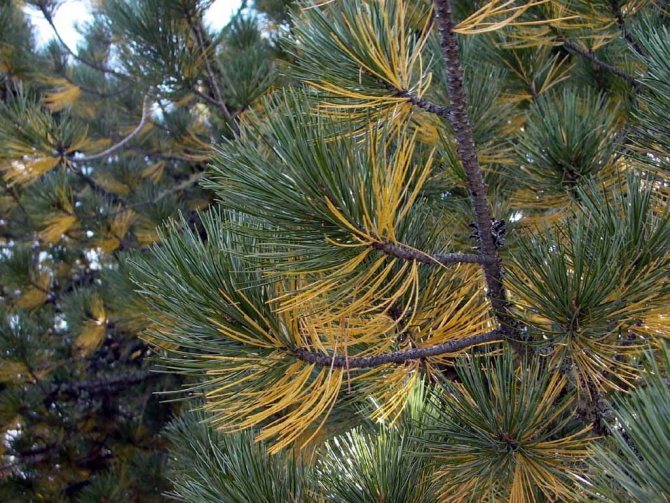

Yellowing needles are a sign of improper care
The most common causes of such problems are:
- Excessive waterlogging of the soil. In this case, a drainage device will help.
- Drying out of the roots. This most often affects moisture-loving yews and thujas, as well as any young plants, the watering of which should be given special attention.
- Wrong location. The needles turn yellow and crumble in direct sunlight. Therefore, you need to pay attention to the preferences of a particular plant. Most conifers prefer partial shade.
They can also suffer from air pollution from toxic emissions from industrial plants and vehicles.
Conifers are quite resistant to infectious diseases, but they can be affected by fungal infections.The fungi grow into the trunk and interfere with the free movement of water and nutrients.
For reference. Only conifers are ill with the fungal infectious disease Schütte. Especially weak, young and recently transplanted. The disease manifests itself in the spring of the year following the infection, so it is impossible to "catch" it in time. It is characterized by yellowing and shedding of needles, the appearance of white, gray or black bloom on the shoots.


Signs of Schütte's disease
Plants are treated with biological products such as Fundazol or Fitosporin, treating them several times with a break of 7-10 days. You can also use a 1% solution of copper sulfate.
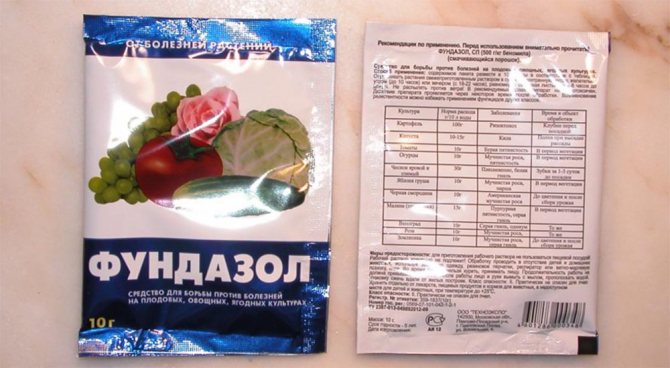

Fundazol is a complex remedy for many diseases
Juniper: description with photo
Juniper is at the top of the list conifers with bactericidal properties
... The plant is very ancient. Juniper first appeared on the planet about 50 million years ago. Currently, it is customary to refer it to the cypress family. Juniper has about 70 species, among which you can find 30-meter trees and 15-centimeter dwarfs. Each species has its own characteristics regarding not only the appearance, but also regarding the requirements for care and maintenance.
Most often, in summer cottages or in the garden, you can find the following types of juniper:
Before planting a juniper in your garden, it is important to remember that the plant should not be planted near fruit trees, as it is a conductor of diseases such as rust.
Cryptomeria
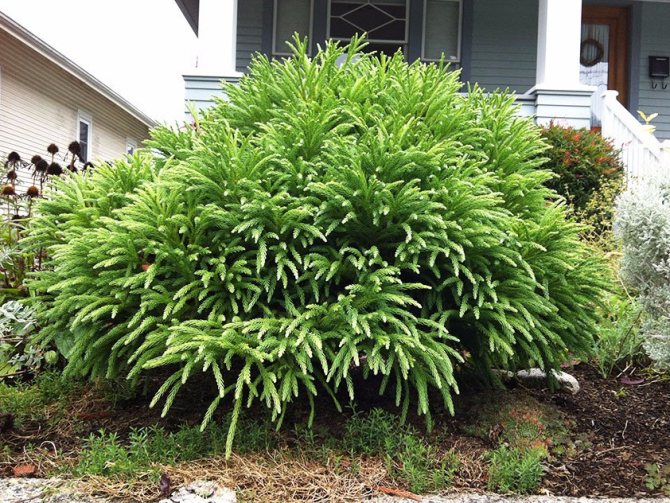

In Japan, this majestic coniferous giant is considered the national tree. It can be found not only in wild forests and on mountain slopes, but also in the design of park alleys. Evergreen cryptomeria grows by the age of 150 to a height of 60 m, in favorable conditions, its trunk cannot be hugged - it can reach 2 m in girth.
Branches with a light or dark shade of needles create a narrow, dense crown. In some trees, for the winter, the needles are filled with a reddish or yellowish tone. They are not prickly to the touch, in appearance they are short, subulate. Cones are round, small, brown in color, ripen throughout the year. Botanists classify cryptomeria to the Cypress family and distinguish it as a single species. The eastern origin of the culture explains its parallel names.
People often call the tree "Japanese cedar", which causes indignation among scientists, since cryptomeria has nothing in common with cedar. The adverbs Shan (Chinese) and Sugi (Japanese) are also used. Contemplating a majestic tree in the wild, it is difficult to even imagine that it can be grown in a backyard or in an apartment. But the breeders took care of this, creating many decorative dwarf forms, reaching a height of no more than 2 m.The varieties of these conifers are represented by varieties: 'Vandai-sugi', 'Еlegans compacta', 'Araucarioides', 'Vilmoriniana', 'Dacrydioides' and spherical 'Compressa', 'Globosa'.
Cedar: description with photo
Cedar is a coniferous tree most commonly found in the aristocratic gardens of England. These conifers are able to decorate the landscape gardening in a peculiar way. Often, cedar varieties are used to decorate front entrances. Dwarf cedar trees can be used for bonsai.
Pine nuts
, which many love, have nothing to do with the cones growing on the cedar. Real cedar cones are not edible. Edible nuts can be found in the cones of the cedar pine that grows in Siberian forests.
The main decorative species of cedar:
- Glauka is a tree with blue needles;
- Stricta - the plant has a columnar crown with dense and short branches, which are slightly raised up;
- Pendula - cedar branches fall down;
- Nana - refers to a dwarf variety.
Pine
These trees with slender trunks, less often shrubs, reach a height of 30 m, some wild species - 80 m.The average age is 150-200 years, although long-lived specimens are known that celebrated their 5000th anniversary. They are not capricious, winter-hardy, tolerate drought well, and require minimal maintenance. The main condition for successful cultivation is excellent drainage to remove excess moisture.


Pine
Loves well-lit places and space. It does not make high demands on the chemical composition of the soil, prefers loams and sandy loams, they often feel great on rocky areas that are poor in nutrients. Of the many species among summer residents, mountain pine is the most popular. She is unpretentious, does not require strenuous care.


Among the many varieties, you can choose a cultivar that ideally suits the existing conditions, with a height of 60 cm to 10-15 m. Saplings delight with a variety: with the usual crown shape, columnar, elliptical, bushy. Pines also differ in the color of the needles - from dark green, monochrome at any time of the year, to variegated, when young needles are colored noticeably lighter than the needles of the previous year.
The genus includes about 40 species. Slender trees in their youth feed on the taproot. Over time, it dies off, its function is performed by lateral branches located close to the surface of the earth. This feature of the root system makes spruces vulnerable to winds. The height of the trees reaches 40 m, the life expectancy is up to 300 years.


The oldest spruce in the world grows in Fulufjellet National Park (Sweden) - its age is more than 5.5 thousand years. Saplings are planted at a distance from buildings - widely spreading roots can cause serious damage even to stone buildings. The place is chosen with good lighting, in the shading the crown is formed asymmetric, and varieties with variegated needles lose their high decorative effect. The plant is picky about the composition of the soil, but it develops better on acidified soil.
In addition to ordinary prickly spruce with reddish-brown bark, summer cottages are often decorated with blue spruce with gray-green needles, usually choosing compact varieties, up to 2-3 m high, as well as variegated ones.


Ideas for using fir trees in landscape design
Cedar, or Siberian cedar pine, is rarely found in summer cottages: the tree requires special care at a young age, although in its natural environment, in the taiga, it grows without problems. The main feature of the species is a very short growing season, only 45 days. Although it is often called a giant tree, its slow growth, as well as a variety of new varieties, make it possible to use it in the design of a summer cottage.
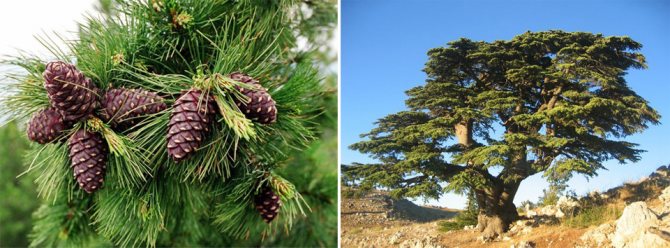

A place for planting a seedling is chosen so that an adult plant is provided with a free space with a diameter of about 10 m. The site should be open, but the young growth needs shading up to 10 years of age, especially during periods of abnormal heat.
The soil is needed with a neutral pH, loose, well-drained. The plant loves regular moistening, top dressing.
Lebanese, Himalayan, Atlas are considered real cedars. Unlike the Siberian relative, their seeds are not suitable for food. The famous pine nuts - the pride of Siberia - taste completely identical to the seeds of any pine, differing only in size.
If you have patience in the summer cottages of different regions, you can grow garden varieties of Siberian cedar, which are compact in size. But the fruits of the required quality are given only by some varieties, the rest are used only for decorative purposes, including for creating compositions in the bonsai style.
Fir
The graceful tree is prone to whims when grown, but its beauty and healing properties are worth all the effort. Of more than 50 plant species in country design, dwarf and undersized varieties of balsamic, Korean, Caucasian species, as well as creeping varieties of Fraser fir, are successfully used. These types are the achievements of breeders, causing a minimum of trouble for summer residents.


The view is great for shaded areas, but does not like the wind. Therefore, they are planted so as to fully meet these requirements, this is especially important for young trees. The best soil is loam that does not retain moisture. It is only important to remember: all firs very painfully tolerate polluted city air, they are only suitable for summer cottages located in clean areas.


Larch
This species annually drops the needles with the onset of cold weather, it is often used to decorate the suburban area. Formed in the bonsai style, it retains its decorative effect even without needle leaves.
Long-lived larch (it lives for over 500 years) has 20 species. All of them, except for the Japanese, categorically do not tolerate the shade. The soil needs fertile, with good drainage and a neutral pH reaction.
The height of the tree usually reaches 30-40 m, but the species lends itself well to pruning, and therefore ordinary full-sized trees are safely planted in the chosen place. Modern varieties, bred from the European variety for the design of small spaces, have increased decorative properties.
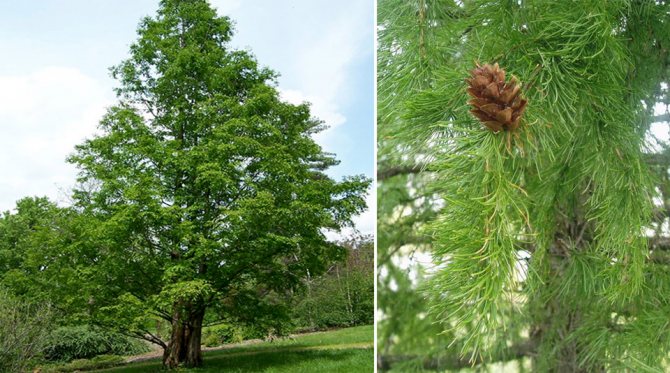

Fir with weeping crowns or pillow-like ones look very attractive. Ultra-miniature cultivars are grown in containers to effectively decorate areas where natural conditions do not allow the plant to be kept outdoors.
Cypress: description and photo
In the wild, these evergreens are capable of growing up to 70 meters in height. Outwardly, the cypress is very similar to the cypress. In landscape design, low-growing coniferous shrubs are often used to create a hedge
... Among gardeners, dwarf cypress species, which do not exceed 3.5 meters in height, are in great demand.
The names of the most popular types of cypress:
Before planting an ephedra, you should pay attention to the fact that dwarf cypress species do not tolerate winter well. They will not freeze under a layer of snow, but they can vanish. This is why it is very important to monitor the density of the snow.
Pine
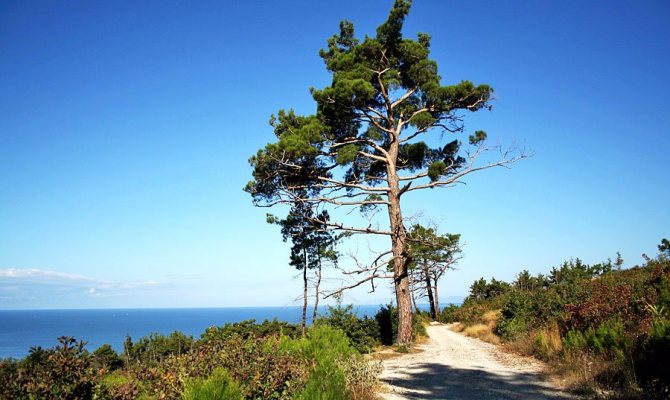

About 115 species of pines (Pinus) are known in the world, but seventeen are widespread in Ukraine, and only eleven of them are cultivated. Pines differ from other coniferous trees with fragrant needles, located on the branches in bunches of 2 - 5 pieces. Depending on their number, the species of pine is determined.
Important! Outdoors, pine roots dry out within 15 minutes. It is better to plan the planting of pines in April-May or mid-September.
For garden collections, breeders have developed many miniature forms with slow growth. In large-scale forest park zones, giant natural species of pines are more common. In small adjoining territories and in the backyard, undersized varieties of pine trees will look spectacular. Such evergreen bushes can be identified in a rock garden, on a lawn or in a mixborder. There are popular varieties of mountain pine, which is found in the wild on Western European slopes and reaches a height of 1.5 to 12 m:
- "Gnom" (characterized by a height and crown diameter of 2 m, needles up to 4 cm long);
- "Columnaris" (shrub up to 2.5 m in height and up to 3 m in width, needles are long and dense);
- "Mops" (trunk up to 1.5 m high, branches form a spherical shape);
- "Mini Mops" (shrub reaches up to 60 cm, grows up to 1 m in diameter, cushion crown);
- "Globosa Viridis" (pine bush height and width about 1 m, ovoid shape, needles up to 10 cm long).
Larch: description with photo
Based on the name, we can assume that this plant should not be coniferous. However, this is a completely erroneous opinion. Larch belongs to the pine family and belongs to the most common conifers
... Outwardly, the plant is a slender tall tree that looks a bit like a spruce. Larch sheds all its needles every autumn.
In favorable living conditions, the diameter of the tree trunk can reach 1 meter, and the height of the larch can reach 50 meters.
Currently, there are about 50 plant species. The most popular ones are the following:
- Vinimalis - weeping;
- Corley - cushion;
- Repens - a tree with creeping branches;
- Kornik is a tree with a spherical crown;
- Diana is a spherical crown, green needles with a smoky shade.
Cupressocyparis
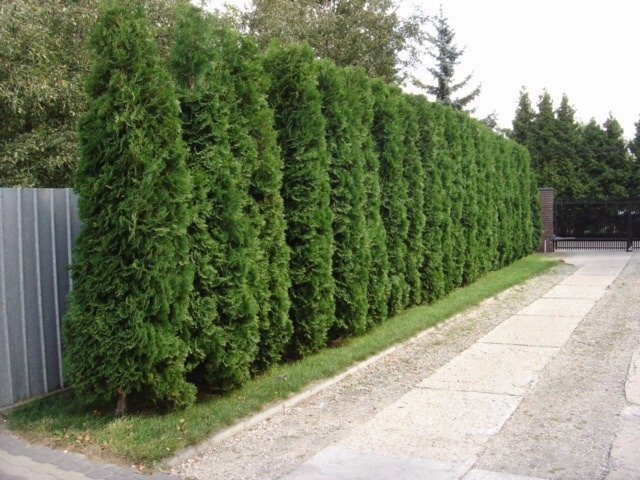

It is a very decorative evergreen tree of a columnar shape, reaching 20 meters in height at maturity. Shoots grow intensively, adding up to 1 m annually. The branches are covered with scaly leaves, develop in one plane. The fruits are small. For many, such a wondrous name is a revelation, therefore, in Ukraine, you can find cupressocyparis only on the sites of advanced collectors and ardent gardeners. In its native UK, where the hybrid is cultivated, it is used to create hedges, especially since the crop is easily adaptable after pruning. In Ukraine, the most common varieties of cupressocyparis Leyland:
- Castlewellan Gold. It is characterized by resistance to wind and frost, not demanding in care. Has a bright golden crown. Young branches of a purple hue.
- Robinson's Gold. Dense green branches form a wide, pin-shaped crown of bronze-yellow color.
- Leithon Green. It is a tree with an openwork crown of a yellowish-green color. The branches are located asymmetrically, the trunk is clearly visible.
- Green Spire. A hybrid with bright yellowish leaves and a slightly columnar shape.
- Haggerston Gray. Differs in loose gray-green branches.
Important! Cupressocyparis grows best on fresh, sufficiently moist and mineral-rich substrates, regardless of the pH level. It is not recommended to plant the plant on waterlogged or dry carbonate soils.
Things to Remember
- Choose conifers for the garden better of three types: yew, cypress, pine. They are most adapted to garden conditions.
- The most popular dwarf varieties and dwarf conifers are: mountain pine "Winter Gold", balsam fir "Hudsonia", Lawson cypress "Minima Aurea", Common juniper "Compress", Scots pine "Pendula", Low spruce "Nidiformis".
- There are certain rules to followto create a healthy and harmonious landscape composition.
- You can create landscape compositions according to ready-made schemes.
- It is desirable to dilute the compositions from conifers with deciduous shrubs and flowers.
Varieties of conifers
The choice of conifers for planting in the summer cottage and garden plots is quite large, and each class of plants is characterized by its own unique features and decorative properties. Below are the main types of decorative conifers, photos and names.
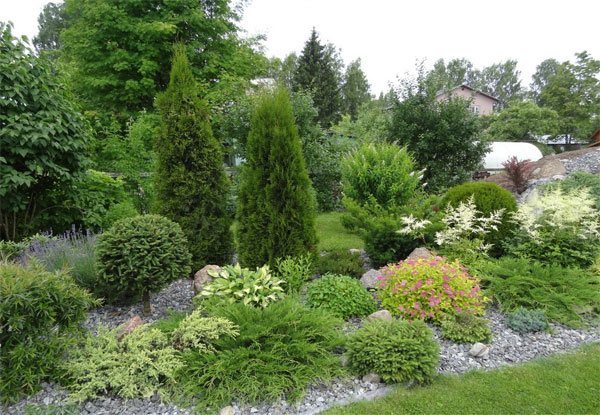

Tall
They are decorative conifers, the height of which does not exceed 2 m. These include:
- Monochrome fir;
- Cedar pine;
- Balsam fir;
- Blue spruce;
- Mountain pine;
- The cypress is dull-leaved.
Their crown needs annual shaping, without which it loses its shape, and the tree loses its decorative qualities.
Deciduous crops are often planted around tall conifers.
Important! Combining different plant species with each other, it is worth considering: over time, the root system of the ephedra tends to grow and take up a fairly large space.
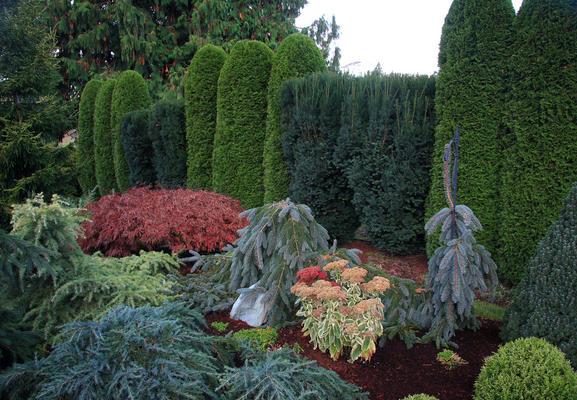

Average
Medium-sized trees are the most demanded representatives of conifers in landscape design, as they are suitable for decorating both small gardens and large-scale plots. Designers often use them as a basis for modeling landscape compositions, as well as as an addition to compact flower gardens.Conifers of medium height include:
- Yew golden;
- Yew berry;
- Pea cypress;
- Tuyu western;
- Canadian hemlock;
- Thuyu spherical.
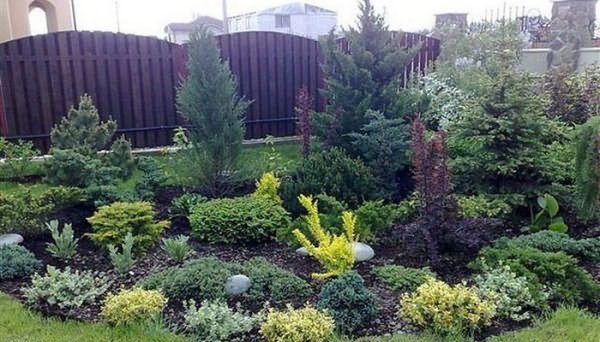

Dwarf
Dwarf conifers have rich decorative properties and a palette of needles colors, which allows them to be used to create unusual and colorful compositions. This type includes:
- Canadian spruce;
- Spherical spruce;
- Spruce prickly;
- Balsam fir;
- The juniper is horizontal.
Often, dwarf coniferous species are used in group plantings, mixborders, rocky gardens and flower beds.


Shade tolerant
Shade-tolerant conifers are a real find for decorating shaded areas. This type of tree does not need constant care, it is used to form hedges, design alpine slides and create decorative groups. Conifers growing in the shade and partial shade include:
- Spruce prickly;
- Canadian yew;
- Siberian fir;
- Canadian spruce;
- Japanese tuevik;
- Echinoformis.
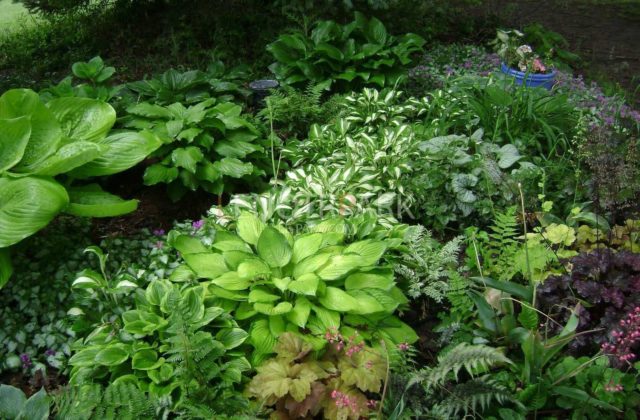

Lifetime.
Some Conifers are some of the longest living plants in the world. For example, the mammoth tree is a long-liver; some of its specimens are more than 3000 years old, but the record for longevity is beaten by another species, namely, the long-lived North American pine (Pinus longaeva). In Eastern Nevada, a specimen of this species was found, the age of which is approximately 4900 years, that is, almost five millennia. This means that already during the construction of the Cheops pyramid, this plant was already quite old (it was more than 200 years old).
Leaves
in most Conifers, narrow and needle-like, such leaves are called needles, but in more ancient genera (for example, in some species of Araucariaceae and Podocarpaceae) the leaves are lanceolate and even broad-lanceolate. So, in the largest podocarp (Podocarpus maximus), the largest leaves reach 35 cm in length and 9 cm in width.
The green leaves of Conifers are most often sessile, but sometimes with a short petiole. Almost always they are whole, and only in some species of fir the leaves at the top are more or less notched. Their length is from 1–2 to 30–40 cm. The longest leaves among modern Conifers are in the North American swamp pine (Pinus palustris), whose needles reach 45 cm in length. With the exception of a few deciduous or branchy genera (araucaria, agathis, taxodium, metasequoia and cunningamia), the leaves of conifers are evergreen, dense, more or less rigid and leathery. The leaf arrangement is usually spiral or alternate, less often whorled or opposite. Narrow leaves (needles) have one vein, wide ones - many parallel veins. In section, the leaves are flat, tetrahedral or rounded.
In addition to green photosynthetic leaves, some Conifers have brown, scale-like leaves.
The subtleties of composing compositions
Ephedra can be combined with each other "playing" with the size and color. For these purposes, both trees and shrubs are used. A combination of trees and deciduous shrubs, flowers. But for the correct composition, you must follow a number of rules:
- For a flower bed to look good in the garden, it is necessary that its point of view is located no closer than two heights of the flower bed. For example, if the flower bed is about a meter high, then the viewpoint should be at least two meters from the decorated area;
- When planted near a pond or stream, conifers look better if several trees or shrubs with drooping branches, similar to willow or alder, are planted to them;
- Dwarf varieties of conifers will decorate the sides of garden paths, but the further the vantage point, the higher the height of the plant should be;
- Conifers often have needles of different colors. This feature needs to be focused on. You should not plant a large group of multi-colored conifers with needles of various shades, it looks variegated and tasteless;
- In order to visualize the composition, you can make prints of images of plants on paper and put them on a large white sheet. This measure will avoid mistakes;
- You should not plant a coniferous plant and birch or bird cherry nearby. These cultures do not tolerate being close to each other. If you decide to plant both on the same territory, then you need to choose only one culture. If the site is large, then they are planted at a distance from each other;
- Spruce and thuja and fir grow poorly next to each other. It is not recommended to plant pine and cedar in the same area. Larch does not like other conifers in the neighborhood;
- When designing a composition, it is necessary to take into account the size of the plants, the shape of their crown, and features. Perhaps, on this issue, you should contact the nursery consultants or read the information in a reliable source;
- Those plants that have the same conditions for normal growth can be planted nearby without fear.
Popular: Six beautiful inflorescences of varieties and types of chestnut tree
Araucariaceae
An ancient family of conifers, according to modern scientists, their age exceeds hundreds of millions of years. The bulk of the genera grows in the Southern Hemisphere, and only one in the Northern. It lives in humid tropical and subtropical forests.


Agathis
Trees, which often reach 70 m in height, tolerate drought calmly and grow well in the shade. The soil is loamy, loose, drained. They are planted in spacious areas protected from the wind. The lower temperature limit is -20 ° C.
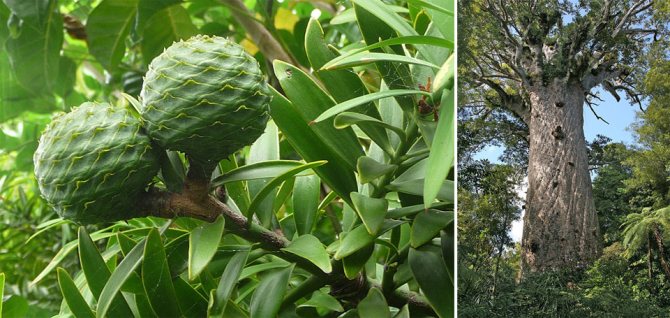

Agathis is interesting for the variety of leaf shapes - from narrow, pointed, typical for conifers, to lanceolate.
Araucaria
Unlike agathis, araucaria do not tolerate frost and are intended mainly for home cultivation. "Kadochnye" specimens rarely grow more than 2 m in height.


In the garden, pots with araucaria are used to decorate flower beds or areas, verandas with good diffused lighting.
Read more about araucaria and caring for it here.
Order - Cordaite
In appearance, they resembled modern conifers. These were plants with powerful trunks. Their leaves were linear from 20-50 cm and more. The organs of reproduction were earrings with male and female cones. Perhaps these plants gave rise to all conifers.
The author of the painting is Zdenek Burian


Zdenek Burian is a Czech artist who painted many paleontological paintings in which he reproduced prehistoric plants, animals and people. In this picture, we see an extinct subclass of conifers.
Variety of deciduous trees
A large number of treesform a deciduous forest.
Let's get acquainted with some representatives of deciduous trees.
The most powerful tree in the forest is considered oak... Our ancestors considered oak to be a sacred tree. The oak is about 50 meters high and has a lifespan of 500 years. But there are also centenarians for more than a thousand years. In autumn they ripen on oak trees acorns.
Fig. 7 ()
These are hearty and nutritious fruits. The squirrel loves to feast on acorns, and will hide it in a hollow in reserve. The forest bird, the jay, is also a lover of delicious fruits. Wild boars also rush after acorns, because they need to accumulate fat in order to survive the winter.
Our ancestors knew: a lot of acorns on an oak - by a harsh winter. Sowing wheat is necessary when the oak leaves unfold. And the oak is also considered a symbol of power and strength. The bravest warriors were awarded with oak wreaths.
People say about cowardly people: "It trembles like an aspen leaf." In reality, the aspen leaf trembles from the slightest breath of wind. This is due to the structure of the petiole... The stalk of the aspen is very thin and long, even in calm weather, the leaves of the aspen quietly rustle... In the spring, before the leaves appear, catkins appear on the aspen. People say: "The fluff flew from the aspen, go to the forest for the boletus."
Fig. 8. Boletus ()
These are mushrooms that love to grow under the aspen.The caps of these mushrooms resemble the autumn coloration of aspen leaves.
What tree is this riddle about?
It takes from my flower
Bee is the most delicious honey.
And everyone offends me
The thin skin is removed.
it Linden. The fragrant, fragrant linden flowers attract bees. And it's not for nothing that bees produce linden honey, it has healing properties. Our ancestors went to the linden tree for bast. This is the inside of the bark. Thin strips were removed from the tree and bast shoes were woven. Linden wood is very soft and white. Furniture, dishes and musical instruments are made from it.
Characteristics of conifers
Conifers include woody and shrub forms. They are found in almost all corners of the world in mixed forests or taiga zone. By the degree of illumination of the areas they occupy, one can judge what kind of conifers there are. The names determine their light-requiring. These are dark coniferous and light coniferous species.
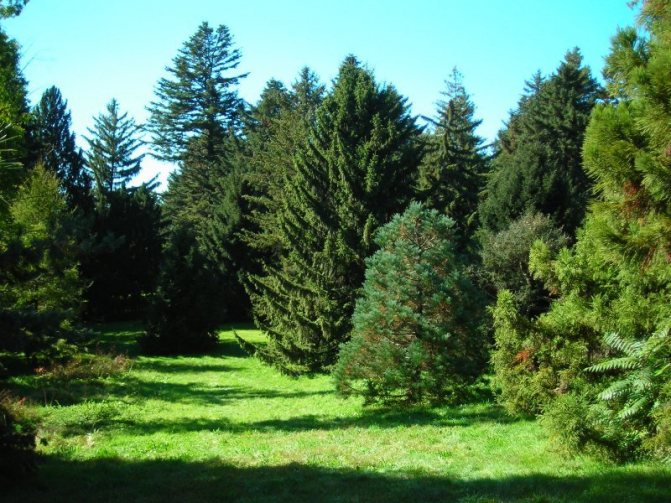

They belong to the most ancient class, which, in turn, includes the following types of families:
- Araucariaceae inhabit the forests of the Southern Hemisphere. Plants of this species are very demanding on moisture and heat. They have wide leaves, large cones and seeds. Bark and wood give off large amounts of resin. They are considered rare and have only about forty varieties.
- Podocarpaceae grow on moist, swampy soils of the Australian continent and Asia. The family includes over one hundred and forty species. Leaves can be of different sizes and shapes.
- Pine are a large family that occupies vast territories. In Siberia, they form natural biomes called taiga. These include more than two hundred and fifty evergreen and deciduous species.
- Cypress grows in northern and southern latitudes. The trees grow up to seventy meters in height and have a very wide trunk. Shrubs are slow growing, can be tall and creeping.
Modern conifers are vascular plants, their seeds develop inside the cones. They are long-livers, the oldest tree is nine thousand years old. And also trees of this species are the record holders in height.
Dark coniferous trees
The taiga expanses occupy large areas. Due to the dense vegetation, it is always twilight. However, some plants prefer thick shade. Their trunks and lower branches are covered with lichens, and the soil is covered with a multi-layer carpet of needles and moss. Despite its harsh appearance, the taiga is very beautiful, many wild animals live in its thickets, and the meadows are covered with flowers and berries.
The tree species of the dark coniferous thicket include:
- Common spruce. It occupies a leading position among its counterparts in popularity. It grows in most of the territory of our country. It has a conical narrow crown and dry lower branches. The needles are dense, small and prickly. Adult specimens grow up to fifty meters in height and live for more than three hundred years. It grows on any soil. The spruce forest is very beautiful both in winter and summer.
- Fir is a tall, slender tree. It has a straight trunk and a narrow conical crown. Dense dark green needles are soft and flat. The needles are much longer than those of the spruce. This plant prefers deaf, darkened places. Craftsmen make various crafts from its soft wood.
- Siberian cedar is a powerful long-lived tree. Its southern variety grows in Lebanon and is a symbol of this state. The needles are triangular in shape, grow in small bunches. Cedar seeds, popularly called nuts, are considered a delicacy.
The fact that all of them are shade-loving speaks of what kind of conifers are in the dense thickets of the taiga. They are united by a common ability to photosynthesize in insufficient sunlight. Due to this, young shoots easily develop under the crowns of adult brethren.
Light coniferous forest
Deciduous or light coniferous taiga zones are typical for regions with a continental climate, where there are short hot summers and cold winters. They grow on soils, under the surface of which there is permafrost.
Stem.
The anatomical structure of coniferous stems is relatively uniform. They have a rather thin bark and a massive woody cylinder, inside which is a core, barely distinguishable in older trunks. Both in the bark and in the wood itself, there are many resin passages (channels), consisting of elongated intercellular spaces. Resin ducts are filled with resin, which is secreted by the lining cells.
Most Conifers have distinct growth rings in the trunk, the formation of which is associated with a slowdown in tree growth during the annual periods of winter cold or summer drought. Each ring corresponds to the growth of wood in one growing season. These rings are distinguishable on cross-sections of the trunk, branches and roots. They are best expressed in conifers in temperate and cold latitudes. By the number of tree rings on the cut of the trunk, carried out at the height of the root collar, it is possible to quite accurately determine the age of the tree. Moreover, on the basis of a number of signs of the structure of the growth ring, it is possible to draw certain conclusions about the climatic conditions of the past. The study of the growth rings of conifers (as well as arboreal Tsvetkovy ones) is used to date archaeological remains and natural phenomena (this method is called dendrochronology), as well as to study the ancient climate (dendroclimatology).
Wild and decorative species of conifers
Decorative varieties of conifers are the result of the work of breeders. Such plants have an aesthetic shape, needles are longer. They are distinguished by the splendor of the crown. In nature, many varieties simply cannot be found, since decorative varieties are more difficult to reproduce. Selected species of conifers cannot fully adapt in natural conditions, they need to be additionally looked after.
Therefore, it is recommended to purchase planting material in the nursery, and not to dig plants in the forest and plant on the site.
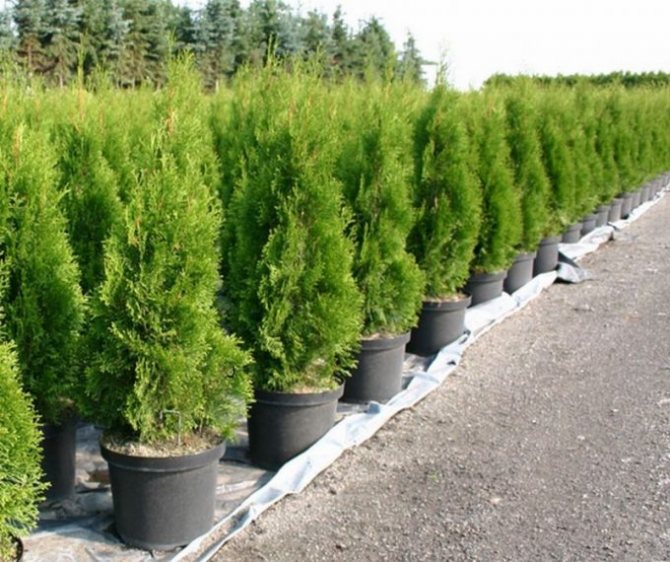

Mr. Dachnik informs
Having decided to plant coniferous trees and bushes in their dacha, they carefully choose seedlings. For purchase, they apply only to specialized nurseries located nearby. This guarantees a good survival rate of the plant, its adaptability to local climatic conditions. To purchase planting material in wide-profile shopping centers is to risk the money spent. In most cases, the plants are planted in a low-quality substrate, overfed with fertilizers and hormones, they will have to be nurtured for a long time, possibly unsuccessfully. Moreover, you should not buy ephedra from random sellers in the market. Together with the seedling, you can bring diseases and pests to the site.
In order for the garden composition to bring joy, they carefully study the rules for planting and growing each species or variety.
With many similar parameters, modern hybrid plants often differ significantly in the requirements for soil composition, the amount of light and moisture.
With a mixed planting, neighboring plants are selected so that their growth conditions coincide with the required coniferous ones - the same irrigation and feeding regulations.
Not all conifers coexist peacefully with deciduous trees and flowers. To avoid plant oppression, carefully study the recommendations of specialists.
Locally adapted Mediterranean or Asian exotic species, as well as local varieties, are used for the following purposes:
- hedge, zoning of the site space;
- design of reservoirs, alpine slides, rockeries;
- curbs and mixborders from low-growing plants;
- solo and various compositions;
- alleys.
Coniferous shrubs with photos and names will help you navigate in the numerous proposals of nurseries.When buying, it is better to take into account not only the features of garden compositions or the unpretentiousness of plants, but also the characteristics of the soil and climate.
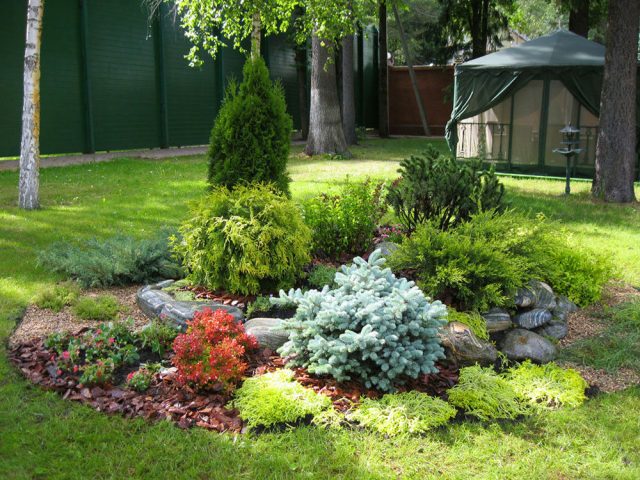

Root.
The primary root in many Conifers persists throughout their life and develops in the form of a powerful taproot, from which lateral roots extend. Less often, for example, in some pines, the primary root is underdeveloped and is replaced by lateral ones. In addition to long roots (main and lateral), Conifers also have short, often highly branched roots, which are the main absorbing organs of the plant. Such roots may contain mycorrhiza - a symbiosis of the mycelium of the fungus and the roots of the plant. Mycorrhizal fungi decompose some organic compounds of the soil inaccessible to the plant, promote the assimilation of phosphates, nitrogen compounds and produce substances such as vitamins, and they themselves use the substances they extract from the roots of the plant.
On the roots of Conifers, there are root hairs near a narrow zone of the root apex, which easily fall off when the root is washed.
Why conifers don't freeze in winter


A narrow conical coniferous tree does not accumulate snow, branches do not freeze in climates with short summers, long and severe winters.
Helps snow slide off easily:
- soft and flexible branches;
- long, thin, needle-like leaves.
Reduces transpiration and controls moisture loss in frosty weather:
- minimum leaf surface area;
- waxy coating of needles.
The needles are usually dark green, absorbing winter sunlight, which is weak at high latitudes.
Conifers are mostly evergreen and the process of nutrient production resumes as soon as warm favorable weather returns in spring.
Spread range
The area of conifers is extensive. Evergreen trees are found in:
- the northern hemisphere, up to the Arctic Circle;
- Europe and Asia;
- Central and South America;
- several species of conifers are endemic to Africa and the tropics.
Coniferous forests grow best where there is a long winter with average to high annual rainfall. The northern Eurasian coniferous forest is called taiga, or boreal forest. Both terms describe an evergreen forest with numerous lakes, swamps and rivers. Coniferous forests also cover mountains in many parts of the world.
Shoots.
Most Conifers have two types of shoots: long shoots that are unlimited in growth (auxiblasts) and shortened shoots that are limited in growth (brachyblasts).
Branching of shoots in Conifers is monopodial. With this type of branching, the main stem (monopodia) developing from the seed has unlimited apical growth, due to which the plant grows in height. The lateral shoots of the first, second, etc. branch off from the monopodia. orders. Shoots extending from the main trunk are arranged in a spiral, but they often come so close that they turn into whorls (rings of shoots around the main trunk), and no more than one such ring of branches is formed annually. Having counted the whorls, you can determine the age of the tree by adding 2 years to the resulting figure, since whorls are not formed in coniferous trees for the first 2 years of life. However, this method is applicable for relatively young (up to 50 years old) plantations, in which the lower whorls on the trunks have not yet had time to completely tighten due to the secondary growth of the trunk.
The branches of such false whorls are gradually shortened upward, which gives the tree a characteristic pyramidal shape. At the same time, the lateral branches of the second and next orders are arranged bilaterally symmetrically, sometimes becoming completely flat, which gives the tree a tiered character. If the apical shoot is damaged, then one of the branches of the youngest whorl of the lateral branches can begin to grow up and take on the role of the main one.Old trees usually have a wide spreading crown, which no longer consists of one, but of several main branches, which is clearly visible, for example, in old pines.
As the tree ages, in an open place, its lower branches can remain, reaching almost to the ground (escaping crown), but in a dense forest they usually die off rather quickly due to lack of light. As a result, the long lower part of the trunk is exposed and remains practically free of knots, which is very valuable when harvesting wood.
In most conifers growing in cold areas, the shoot tip is protected by tightly fitting thin scales that form a pronounced bud at the end of the growing season. The kidney scales are covered with a protective layer of resin or tightly covered with a thick hairline. In other cases, for example, in araucaria and most cypress, kidney scales do not develop.

